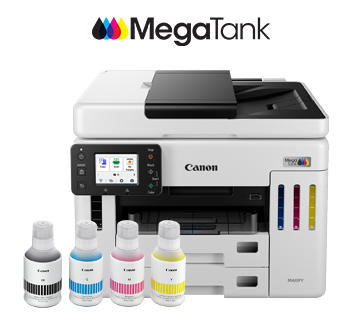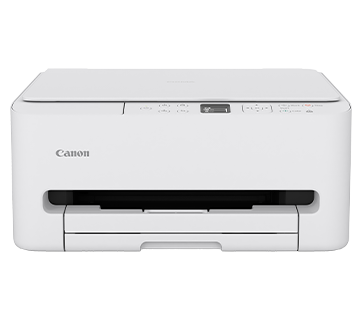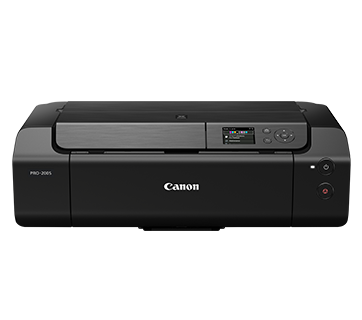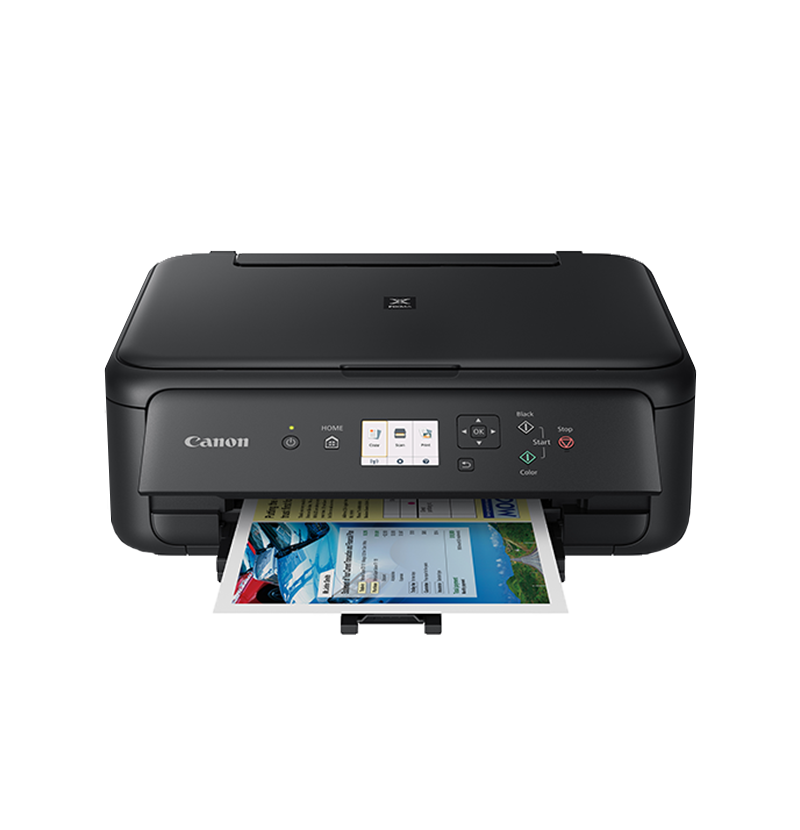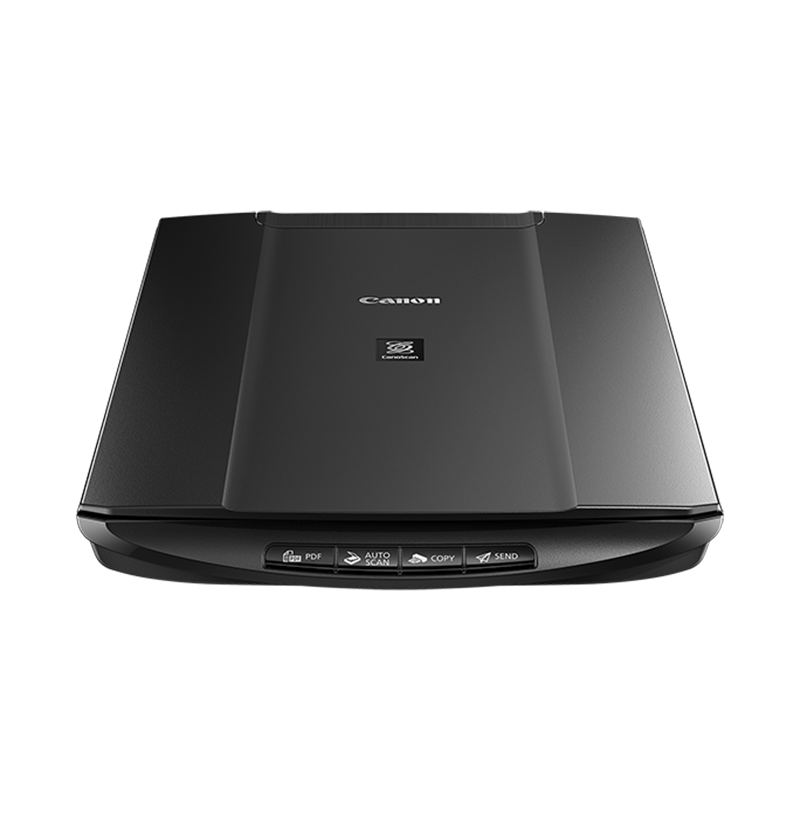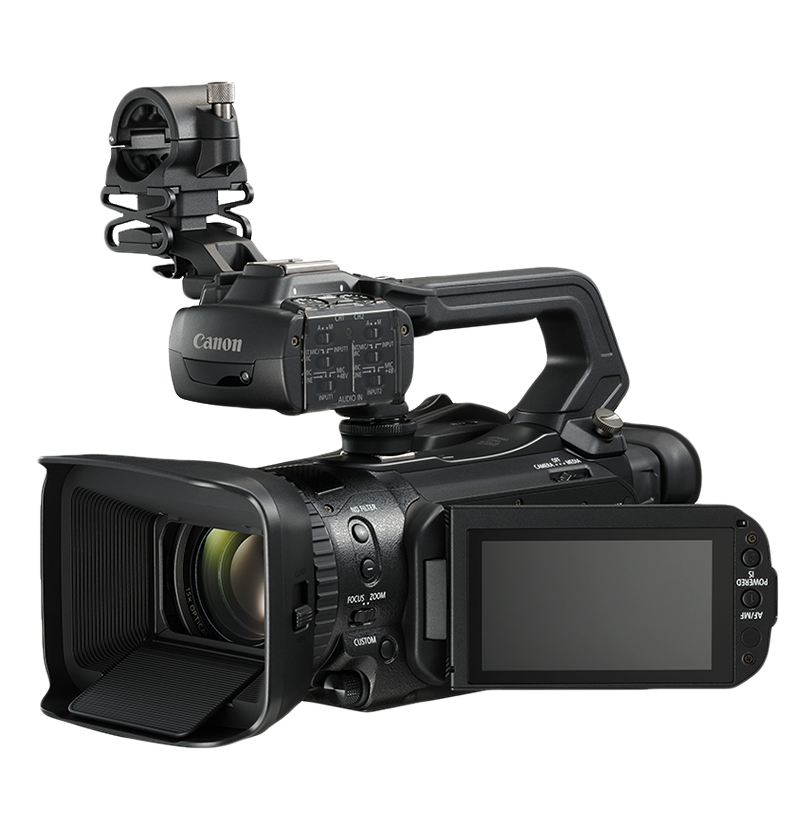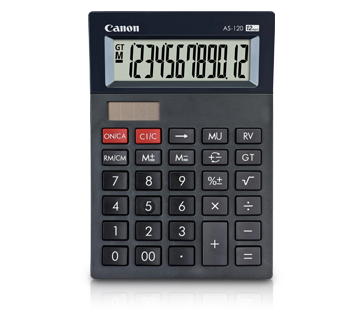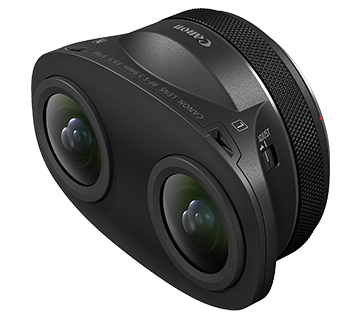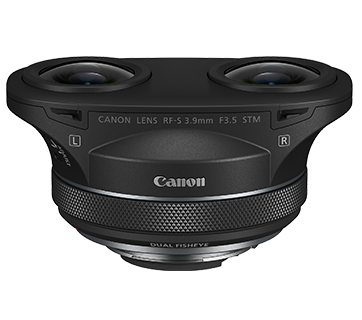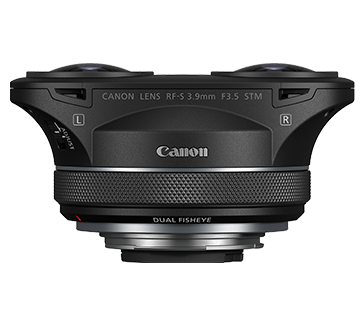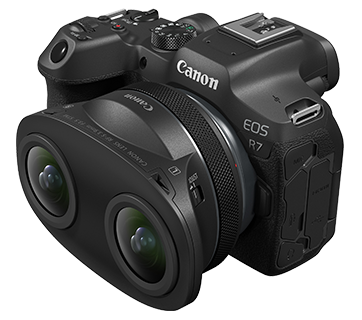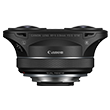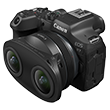RF-S3.9mm f/3.5 STM Dual Fisheye
RF-S3.9mm f/3.5 STM Dual Fisheye
The lightweight RF-S3.9mm f/3.5 STM Dual Fisheye lens with Autofocus can capture 144-degree 3D stereoscopic visuals by utilising the parallax of the left and right fisheye lenses. This design allows a single sensor to receive light from both lenses, making it easier to record Virtual Reality content with just one camera.
Key Features

Stepping Motor (STM)
The RF-S3.9mm f/3.5 STM Dual Fisheye has a gear-type stepping motor (STM) that utilises a dual-lens autofocus (AF) mechanism. This mechanism synchronously controls the movement of the left and right lenses.
AF becomes just as user-friendly as using a regular RF lens. An advanced microprocessor optimises the actuator control to align with the camera's AF algorithm, resulting in fast and accurate autofocus.
Dual-Lens Electro Magnetic Diaphragm (EMD)
Both left and right lenses of the RF-S3.9mm f/3.5 STM Dual Fisheye feature EMD that controls exposure electronically.
The large aperture of the RF-S3.9mm f/3.5 STM Dual Fisheye performs well in low-light situations.
Two Types of Filters
The RF-S3.9mm f/3.5 STM Dual Fisheye has a rear filter holder that can hold either a gelatin filter or a screw-on (30.5mm) type filter.
Using a Neutral Density (ND) filter, you can shoot with a wider aperture even when shooting outdoors during the day.
ASC
Air Sphere Coating (ASC) is a coating technology that provides even more excellent anti-reflection properties than conventional vapour-deposition coatings.
Even with large-aperture lenses, ASC is used on curved glass surfaces to reduce lens flare and ghosting.
Adjustable Focus Differential
The RF-S3.9mm f/3.5 STM Dual Fisheye has an actuator that can independently drive only the right lens.
This enables the relative focus of the left and right lenses to be adjusted using the left-right focus difference adjustment mode switch and the focusing/control ring.

How Virtual Reality Imaging Works
Two Fisheye Lenses
Recording is done with parallax using two fisheye lenses on one sensor.
Conversion
The software converts recordings into equirectangular projections, a standard Virtual Reality format.
Projected to HMD
Cropped and converted recordings are projected into a head-mounted display (HMD) to simulate a human's vision.
3D Realism
Due to the parallax effect, the recordings will appear 3-dimensional (3D) when viewed individually by the left and right eye.
Mechanism of Virtual Reality Recording

Single-Sensor Recording
With the RF-S3.9mm f/3.5 STM Dual Fisheye attached to the EOS R7 mirrorless camera, users can take advantage of the camera's recording capabilities to create 4K 144-degrees VR footage by using just one camera on one sensor.
Two Cameras No Longer Required
Conventional VR recording requires aligning two cameras and syncing camera positions, with additional processes like colour matching and stitching required after shooting. The RF-S3.9mm f/3.5 STM Dual Fisheye and EOS R7 have a single-sensor recording capability, eliminating such hassles.
A More Efficient Workflow
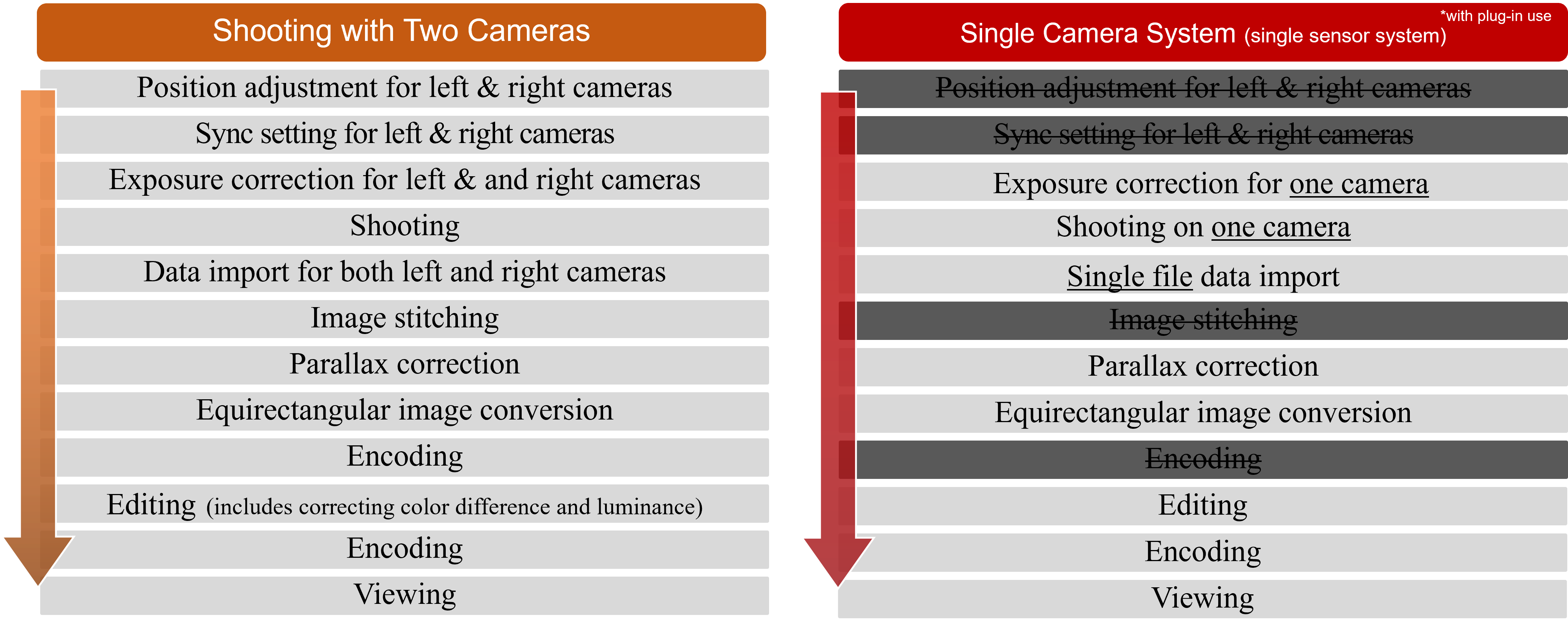
The RF-S3.9mm f/3.5 STM Dual Fisheye enables recording on a single camera with one CMOS image sensor, thereby eliminating certain stages from the workflow that were previously necessary with a two-camera system, such as aligning the positions and synchronising the settings of the left and right cameras before the shoot, or the need to stitch images in post-production.
Virtual Reality
Storytelling
Make your story different
Software Integration for Post-Production
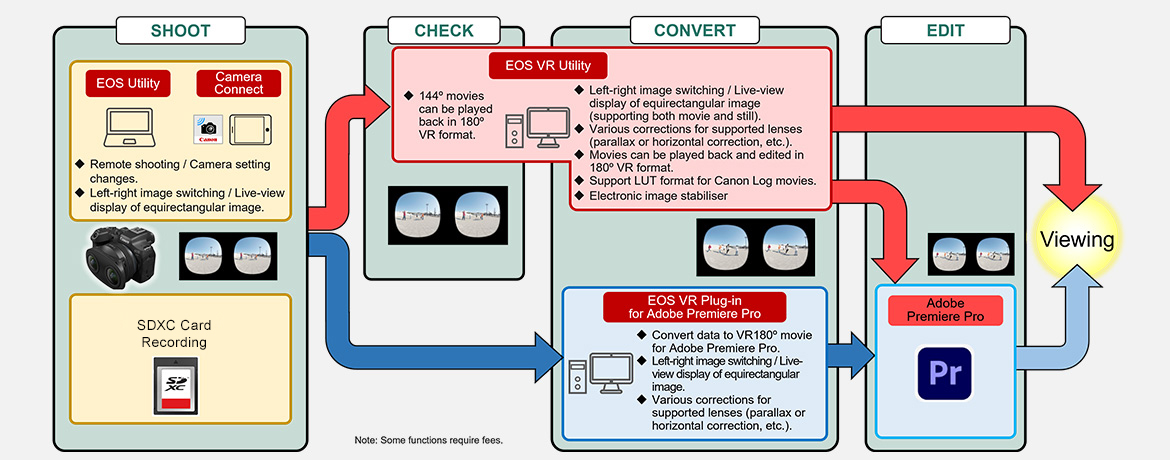
Software support allows for a more efficient and simplified workflow during post-production.
EOS VR Utility*
- A computer software application that lets users convert images into equirectangular projections (a standard VR image format) and perform simple editing on them.
- Supports toggling between images/footage shot by the left and right lenses. Also supports toggling between circular fisheye and equirectangular displays.
- Supports image straightening/parallax correction for compatible lenses
- Supports playback and basic cutting of 180-degree VR images on computer monitors.
- Videos recorded in 8K can be converted and saved in a different size, file specification, or format.
- LUTs (Lookup Tables) can be applied to videos recorded in Canon Log mode.
- Supports output to DPX (Digital Picture Exchange) and Apple ProRes for NLE (non-linear editing) purposes.
EOS VR Plugin* for Adobe Premiere Pro
- A computer software plugin for video creators who edit with Adobe Premiere Pro.
- Supports swapping the left and right images and converting images into equirectangular projections (a standard VR image format).
- Supports image straightening/parallax correction for compatible lenses
*subscription fee and/or payment required for full feature (conversion of footage that are 2 minutes or longer).
*does not support Apple Silicon yet.
Sample 3D VR videos
This sample video was shot on the RF-S3.9mm f/3.5 STM Dual Fisheye and EOS R7, and output as a 2D VR video so you don’t need 3D goggles to experience it. You can use your mouse, keyboard, or touch gestures to move around the scene, zoom in, or zoom out.
The EOS VR SYSTEM enables users to use compatible cameras, lenses and image processing software to explore 180° Stereoscopic VR (Virtual Reality) videos and images.
Advanced User Guide and Instruction Manual available for download.
*Multiple Exposure mode compatibility, please refer here.
*Source for instruction manuals and software for EOS, EOS accessories, lenses, PowerShot, SELPHY and professional video products in various supported languages.
https://cam.start.canon/
Specifications
Specifications
Specifications
| 144°00′ | |
| 144°00′ | |
| 144°00′ | |
| 0.2 / 0.66 | |
| 8,11 | |
| 112.0 × 83.7 (height) x 54.6 | |
| - | |
| Gear-type STM | |
| Screw-on filter (30.5mm) or gelatin filter can be attached to rear filter holder | |
| 0.03x | |
| 16 | |
| 7 | |
| Not Supported | |
| 290 (without rear filter holder attached) | |
| Canon Lens Cap 3.9 (center pinch type) & Lens Dust Cap RF (included) | |
| Not Supported | |
| LS1014 (sold separately) |
Specifications
| 144°00′ | |
| 144°00′ | |
| 144°00′ | |
| 0.2 / 0.66 | |
| 8,11 | |
| 112.0 × 83.7 (height) x 54.6 | |
| - | |
| Gear-type STM | |
| Screw-on filter (30.5mm) or gelatin filter can be attached to rear filter holder | |
| 0.03x | |
| 16 | |
| 7 | |
| Not Supported | |
| 290 (without rear filter holder attached) | |
| Canon Lens Cap 3.9 (center pinch type) & Lens Dust Cap RF (included) | |
| Not Supported | |
| LS1014 (sold separately) |
Where To Buy / Service
Product Disclaimer
- 01. Prices, specifications, availability and terms of offers may change without notice.
- 02. Products / Services may be manufactured by and/or supplied to us by third party manufacturers/suppliers for distribution / resale (non-Canon brand products).
- 03. Prices above are recommended retail price in Malaysian Ringgit and may change without prior notice.

